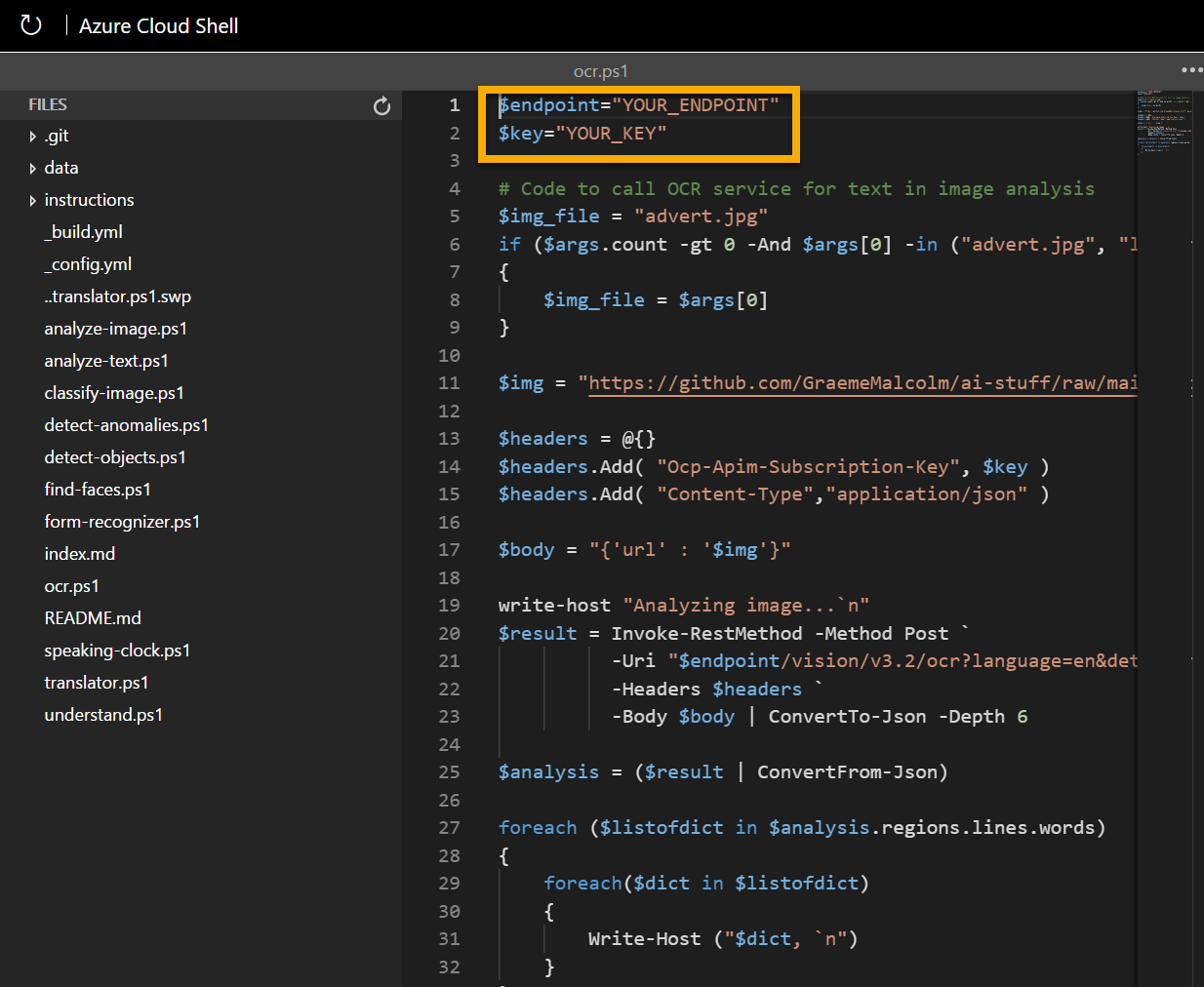Analyze Text in Images with Optical Character Recognition
A common computer vision challenge is to detect and interpret text in an image. This kind of processing is often referred to as optical character recognition (OCR).
Use the Computer Vision Service to Read Text in an Image
The Computer Vision cognitive service provides support for OCR tasks, including:
- An OCR API that you can use to read text in multiple languages. This API can be used synchronously, and works well when you need to detect and read a small amount of text in an image.
- A Read API that is optimized for larger documents. This API is used asynchronously, and can be used for both printed and handwritten text.
You can use this service by creating either a Computer Vision resource or a Cognitive Services resource.
If you haven’t already done so, create a Cognitive Services resource in your Azure subscription.
Note: If you already have a Cognitive Services resource, just open its Quick start page in the Azure portal and copy its key and endpoint to the cell below. Otherwise, follow the steps below to create one.
-
In another browser tab, open the Azure portal at https://portal.azure.com, and sign in with your Microsoft account.
- Click the +Create a resource button, search for Cognitive Services, and create a Cognitive Services resource with the following settings:
- Subscription: Your Azure subscription.
- Resource group: Select or create a resource group with a unique name.
- Region: Choose any available region:
- Name: Enter a unique name.
- Pricing tier: S0
- I confirm I have read and understood the notices: Selected.
- Review and create the resource, and wait for deployment to complete. Then go to the deployed resource.
- View the Keys and Endpoint page for your Cognitive Services resource. You will need the endpoint and keys to connect from client applications.
Use a cloud shell
To test the capabilities of the Custom Vision service to detect objects in images, we’ll use a simple command-line application that runs in the cloud shell.
Note: For this lab, you will test out an application in a cloud shell environment. When you build your own application, you can use an environment of your choice.
-
Click the Activate Sandbox button at the top of the page. This starts a Cloud Shell instance to your right, as shown here. You may be prompted to review permissions. Click Accept.

-
When you open the cloud shell, you will need to change the type of shell you are using from Bash to PowerShell. Type in pwsh and press enter.
pwsh
Configure and run a client application
Now that you have a cloud shell environment, you can run a simple client application that uses the Computer Vision service to analyze an image.
-
In the command shell, enter the following command to download the sample application.
git clone https://github.com/GraemeMalcolm/ai-stuff ai-900 -
The files are downloaded to a folder named ai-900. Now we want to see all of the files in your cloud shell storage and work with them. Type the following command into the shell:
code .Notice how this opens up an editor.
-
In the Files pane on the left, expand ai-900 and select ocr.ps1. This file contains some code that uses the Computer Vision service to detect and analyze text in an image, as shown here:

-
Don’t worry too much about the details of the code, the important thing is that it needs the endpoint URL and either of the keys for your Computer Vision resource. Copy these from the Keys and Endpoints page for your resource (which should still be in the top area of the browser) and paste them into the code editor, replacing the YOUR_ENDPOINT and YOUR_KEY placeholder values respectively.
Tip: You may need to use the separator bar to adjust the screen area as you work with the Keys and Endpoint and Editor panes.
After pasting the endpoint and key values, the first two lines of code should look similar to this:
$endpoint="https://resource.cognitiveservices.azure.com/" $key="1a2b3c4d5e6f7g8h9i0j...." -
At the top right of the editor pane, use the … button to open the menu and select Save to save your changes. Then open the menu again and select Close Editor. Now that you’ve set up the key and endpoint, you can use your Cognitive Services resource to extract text from an image.
Let’s start with the OCR API, which enables you to synchronously analyze an image and read any text it contains. In this case, you have an advertising image for the fictional Northwind Traders retail company that includes some text.
The sample client application will analyze the following image:

-
In the PowerShell pane, enter the following commands to run the code to read the text:
cd ai-900 .\ocr.ps1 advert.jpg -
Review the details found in the image. The text found in the image is organized into a hierarchical structure of regions, lines, and words, and the code reads these to retrieve the results.
Note that the location of text is indicated by the top- left coordinates, and the width and height of a bounding box, as shown here:

-
Now let’s try another image:

To analyze the second image, enter the following command:
.\ocr.ps1 letter.jpg -
Review the results of the analysis for the second image.
-
Let’s try one more:

To analyze the third image, enter the following command:
.\ocr.ps1 note.jpg -
Review the results of the analysis for the third image.
Learn more
This simple app shows only some of the OCR capabilities of the Computer Vision service. To learn more about what you can do with this service, see the OCR page.